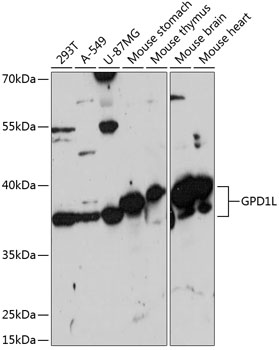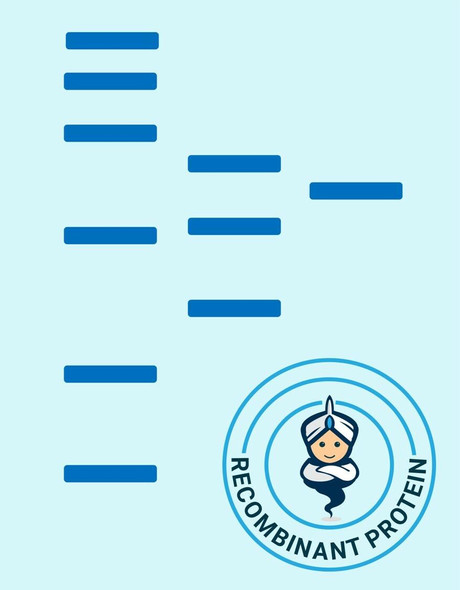Cell Biology Antibodies 5
Anti-GPD1L Antibody (CAB14392)
- SKU:
- CAB14392
- Product Type:
- Antibody
- Reactivity:
- Human
- Reactivity:
- Mouse
- Host Species:
- Rabbit
- Isotype:
- IgG
- Antibody Type:
- Polyclonal Antibody
- Research Area:
- Cell Biology
Description
| Antibody Name: | Anti-GPD1L Antibody |
| Antibody SKU: | CAB14392 |
| Antibody Size: | 20uL, 50uL, 100uL |
| Application: | WB |
| Reactivity: | Human, Mouse |
| Host Species: | Rabbit |
| Immunogen: | Recombinant fusion protein containing a sequence corresponding to amino acids 1-351 of human GPD1L (NP_055956.1). |
| Application: | WB |
| Recommended Dilution: | WB 1:500 - 1:2000 |
| Reactivity: | Human, Mouse |
| Positive Samples: | 293T, A-549, U-87MG, Mouse stomach, Mouse thymus, Mouse brain, Mouse heart |
| Immunogen: | Recombinant fusion protein containing a sequence corresponding to amino acids 1-351 of human GPD1L (NP_055956.1). |
| Purification Method: | Affinity purification |
| Storage Buffer: | Store at -20'C. Avoid freeze / thaw cycles. Buffer: PBS with 0.02% sodium azide, 50% glycerol, pH7.3. |
| Isotype: | IgG |
| Sequence: | MAAA PLKV CIVG SGNW GSAV AKII GNNV KKLQ KFAS TVKM WVFE ETVN GRKL TDII NNDH ENVK YLPG HKLP ENVV AMSN LSEA VQDA DLLV FVIP HQFI HRIC DEIT GRVP KKAL GITL IKGI DEGP EGLK LISD IIRE KMGI DISV LMGA NIAN EVAA EKFC ETTI GSKV MENG LLFK ELLQ TPNF RITV VDDA DTVE LCGA LKNI VAVG AGFC DGLR CGDN TKAA VIRL GLME MIAF ARIF CKGQ VSTA TFLE SCGV ADLI TTCY GGRN RRVA EAFA RTGK TIEE LEKE MLNG QKLQ GPQT SAEV YRIL KQKG LLDK FPLF TAVY QICY ESRP VQEM LSCL QSHP EHT |
| Gene ID: | 23171 |
| Uniprot: | Q8N335 |
| Cellular Location: | Cytoplasm |
| Calculated MW: | 38kDa |
| Observed MW: | 38kDa |
| Synonyms: | GPD1L, GPD1-L |
| Background: | The protein encoded by this gene catalyzes the conversion of sn-glycerol 3-phosphate to glycerone phosphate. The encoded protein is found in the cytoplasm, associated with the plasma membrane, where it binds the sodium channel, voltage-gated, type V, alpha subunit (SCN5A). Defects in this gene are a cause of Brugada syndrome type 2 (BRS2) as well as sudden infant death syndrome (SIDS). |
| UniProt Protein Function: | GPD1L: Plays a role in regulating cardiac sodium current; decreased enzymatic activity with resulting increased levels of glycerol 3-phosphate activating the DPD1L-dependent SCN5A phosphorylation pathway, may ultimately lead to decreased sodium current; cardiac sodium current may also be reduced due to alterations of NAD(H) balance induced by DPD1L. Defects in GPD1L are the cause of Brugada syndrome type 2 (BRGDA2). An autosomal dominant tachyarrhythmia characterized by right bundle branch block and ST segment elevation on an electrocardiogram (ECG). It can cause the ventricles to beat so fast that the blood is prevented from circulating efficiently in the body. When this situation occurs (called ventricular fibrillation), the individual will faint and may die in a few minutes if the heart is not reset. Defects in GPD1L are a cause of sudden infant death syndrome (SIDS). SIDS is the sudden death of an infant younger than 1 year that remains unexplained after a thorough case investigation, including performance of a complete autopsy, examination of the death scene, and review of clinical history. Pathophysiologic mechanisms for SIDS may include respiratory dysfunction, cardiac dysrhythmias, cardiorespiratory instability, and inborn errors of metabolism, but definitive pathogenic mechanisms precipitating an infant sudden death remain elusive. Belongs to the NAD-dependent glycerol-3-phosphate dehydrogenase family. |
| UniProt Protein Details: | Protein type:Lipid Metabolism - glycerophospholipid; Oxidoreductase; EC 1.1.1.8 Chromosomal Location of Human Ortholog: 3p22.3 Cellular Component: cytosol; plasma membrane Molecular Function:glycerol-3-phosphate dehydrogenase (NAD+) activity; sodium channel regulator activity Biological Process: NAD metabolic process; negative regulation of peptidyl-serine phosphorylation; phosphatidic acid biosynthetic process; regulation of heart rate; triacylglycerol biosynthetic process Disease: Brugada Syndrome 2 |
| NCBI Summary: | The protein encoded by this gene catalyzes the conversion of sn-glycerol 3-phosphate to glycerone phosphate. The encoded protein is found in the cytoplasm, associated with the plasma membrane, where it binds the sodium channel, voltage-gated, type V, alpha subunit (SCN5A). Defects in this gene are a cause of Brugada syndrome type 2 (BRS2) as well as sudden infant death syndrome (SIDS). [provided by RefSeq, Jul 2010] |
| UniProt Code: | Q8N335 |
| NCBI GenInfo Identifier: | 74750945 |
| NCBI Gene ID: | 23171 |
| NCBI Accession: | Q8N335.1 |
| UniProt Secondary Accession: | Q8N335,Q14702, Q9BRM5, A8K9U3, |
| UniProt Related Accession: | Q8N335 |
| Molecular Weight: | 38,419 Da |
| NCBI Full Name: | Glycerol-3-phosphate dehydrogenase 1-like protein |
| NCBI Synonym Full Names: | glycerol-3-phosphate dehydrogenase 1-like |
| NCBI Official Symbol: | GPD1L |
| NCBI Official Synonym Symbols: | GPD1-L |
| NCBI Protein Information: | glycerol-3-phosphate dehydrogenase 1-like protein |
| UniProt Protein Name: | Glycerol-3-phosphate dehydrogenase 1-like protein |
| Protein Family: | Glycerol-3-phosphate dehydrogenase 1-like protein |
| UniProt Gene Name: | GPD1L |
| UniProt Entry Name: | GPD1L_HUMAN |
View AllClose



![GPD1L Monoclonal Antibody [PAT14E2AT] (CPAB0236) GPD1L Monoclonal Antibody [PAT14E2AT] (CPAB0236)](https://cdn11.bigcommerce.com/s-rd6ounxcu2/images/stencil/590x590/products/58461/63643/gpd1l-monoclonal-antibody-pat14e2at-cpab0236__90287__42771.1706535019.jpg?c=1)



